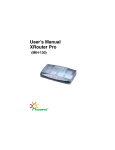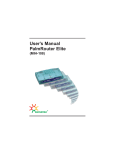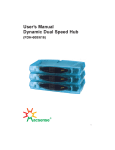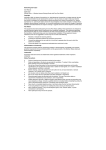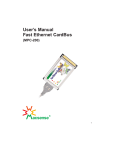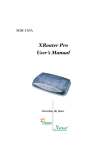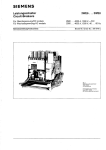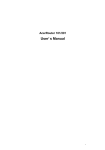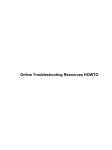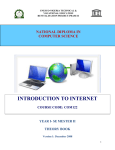Download Macsense Connectivity MIH-120 User`s manual
Transcript
User’s Manual XRouter (MIH-120) acsense R . Copyright Copyright © 1999 by this company. All rights reserved. No part of this documentation may be reproduced in any form or by any means or used to make any directive work (such as translation or transformation) without permission from Macsense Connectivity, Inc. Macsense Connectivity, Inc. reserves the right to revise this documentation and to make changes in content without obligation among Macsense Connectivity, Inc. to provide notification of such revision or change. FCC Notice This equipment has been tested and found to comply with the limits for a Class B digital device, pursuant to Part 15 of FCC Rules. These limits are designed to provide protection against harmful interference in residential installations. This equipment generates radio frequencies that may cause interference with radio communications if not used in accordance with the instructions. Interference may even occur with proper installation. If this equipment causes interference, the user is encouraged to correct the interference with one or more of the following measures: 1. Reorient or relocate the receiving antenna. 2. Increase the separation between the equipment and receiver. 3. Connect the equipment into an outlet on a circuit that is separate from the one to which the receiver is connected. 4. Consult the dealer or an experienced radio/television technician for help. i Safety Precautions 1. Follow all warnings and instructions marked on the product. 2. Slots and openings on the device are provided for ventilation. To protect it from overheating, these openings must not be blocked or covered. 3. Do not use or store this product in an environment that exceeds temperature and humidity specifications. Do not place this product near a radiator or heat register, or in a built-in installation unless adequate ventilation is provided. 4. Before cleaning this product, unplug from wall outlet. Do not use liquid cleaners or aerosol cleaners. Use a damp cloth for cleaning. 5. Do not place cords or cables where they may be walked on or tripped over. 6. Be sure to comply with any applicable local safety standards or regulations. 7. General purpose cables are provided with this product. Any cables or other requirements mandated by local authority are your responsibility. 8. Cables that are attached to devices in different locations that have different power sources and grounding may have hazardous voltage potentials. Consult a qualified electrical consultant before installing the product to see if this phenomenon exists and, if necessary, take corrective action. 9. Never touch annunciated telephone wires or terminals unless the line has been disconnected. 10. Avoid using telephone equipment or installing the product during an electrical storm. 11. Never install telephone jacks, lines, network cables, this product, or power connections in wet locations. 12. Never spill liquid of any kind on the product. ii Table of Contents ABOUT THIS MANUAL . . . . . . . . . . . . . . . . . . . . . . . . . . .1 INTRODUCTION . . . . . . . . . . . . . . . . . . . . . . . . . . . . . . . . .2 BEFORE YOU START . . . . . . . . . . . . . . . . . . . . . . . . . . . .4 Package Overview . . . . . . . . . . . . . . . . . . . . . . . . . . . . .4 Items Required . . . . . . . . . . . . . . . . . . . . . . . . . . . . . . . .4 System Requirements . . . . . . . . . . . . . . . . . . . . . . . . . .4 EASY INSTALLATION . . . . . . . . . . . . . . . . . . . . . . . . . . . .5 Hardware Installation . . . . . . . . . . . . . . . . . . . . . . . . . . .5 Software Configuration . . . . . . . . . . . . . . . . . . . . . . . . . .8 Windows 95 TCP/IP Configuration . . . . . . . . . . . . . . . . .8 Mac OS TCP/IP Configuration . . . . . . . . . . . . . . . . . . .12 Setting up the XRouter Through a Web Browser . . . . . .14 ADVANCED CONFIGURATION . . . . . . . . . . . . . . . . . . . . .17 DHCP Server Settings . . . . . . . . . . . . . . . . . . . . . . . . . .17 Virtual Server . . . . . . . . . . . . . . . . . . . . . . . . . . . . . . . . .18 Device Administration . . . . . . . . . . . . . . . . . . . . . . . . . . .19 Status Monitor . . . . . . . . . . . . . . . . . . . . . . . . . . . . . . . .19 DMZ Host . . . . . . . . . . . . . . . . . . . . . . . . . . . . . . . . . . .19 Firmware Upgrade . . . . . . . . . . . . . . . . . . . . . . . . . . . . .20 TROUBLESHOOTING . . . . . . . . . . . . . . . . . . . . . . . . . . . .21 APPENDIX A SPECIFICATIONS . . . . . . . . . . . . . . . . . . . .22 APPENDIX B Hardware Description . . . . . . . . . . . . . . . .23 APPENDIX C GLOSSARY . . . . . . . . . . . . . . . . . . . . . . . . .25 iii About This Manual ABOUT THIS MANUAL This user manual describes how to connect a LAN to the Internet using the XRouter Internet Sharing Hub, MIH-120. This manual assumes you are familiar with the basics of personal computing and network environments. The material is organized as follows: Chapter Content Introduction Describes the features and main applications of the XRouter Before You Start Describes the environment needed to set up the XRouter Easy Installation Describes how to install the XRouter for ordinary applications Advanced Configuration Describes the configuration options for the XRouter Troubleshooting Lists problems and solutions one might encounter when using the XRouter Appendix A Hardware Description Appendix B Specifications Appendix C Glossary 1 Introduction INTRODUCTION Thank you for purchasing the XRouter MIH-120 Internet Sharing Hub. The XRouter functions as an easy-to-use communication device that allows you to connect a local area network (LAN) to the Internet affordably. With the XRouter you can get as many as 252 Macintosh or PC users online simultaneously through just one cable line or DSL, and one ISP account. The XRouter installs quickly and easily, and best of all, it’s a breeze to use. Sharing Internet Access The XRouter provides high-speed Internet access to multiple users by splitting the bandwidth from a cable line or from DSL (Digital Subscriber Line) into tiny portions and then routing these bandwidth “slices” to almost any number of Internet users. The fewer the number of users online at any one time, the faster the service each individual receives. Internet users on different nodes are not limited to looking at the same Web pages. Each node is functionally independent from the other nodes connected to the XRouter. Modems Supported The XRouter supports cable modems and DSL modems. The XRouter has one WAN (Wide Area Network) port for connecting the unit to either a cable modem or a DSL modem. Either technology should provide more than enough bandwidth to accommodate the needs of even large groups of Internet users. Built-in DHCP Server The XRouter’s built-in DHCP Server dramatically reduces the configuration and maintenance effort by allowing you to automatically configure the TCP/IP setting of computers over a local area network. 2 Introduction 4-Port Ethernet Hub Inside In addition to providing Internet sharing capability, the XRouter also functions as an Ethernet hub, offering four 10BASE-T, RJ-45 ports that allow you to connect a series of computers to form a small LAN. Easy Configuration The XRouter can be configured through a Web browser, and features Web-based management for a simple, intuitive set up. Virtual Server Internet users can set up an in-house Web server, such as WWW or FTP, through the XRouter’s Virtual Server mapping function. The Virtual Server allows you to select a particular computer in your network to respond to outside Internet requests. Security The XRouter provides firewall-like security through NAT (Network Address Translation) to prevent unauthorized Internet users from accessing internal files. It can also filter out Internet requests from certain nodes on a local network for administrative purposes. NAT (Network Address Translation) The XRouter features NAT (Network Address Translation) as a means of translating private IP addresses into a global IP address that is, in turn, registered to the Internet. NAT essentially masks local IP addresses to the outside world, allowing a group of Internet users to share a single ISP account (which means you don’t have to buy separate accounts for each user). 3 Before You Start BEFORE YOU START Package Overview Please check to make sure your XRouter package includes the items listed below before setting up your XRouter. __ an XRouter __ a power adapter __ this user manual __ a Category-5 UTP cable with RJ-45 connectors Items Required __ an account from an ISP (Internet Service Provider) __ a cable line or DSL __ a cable modem or DSL modem __ additional UTP cables with RJ-45 connectors (for additional computers) System Requirements • Computer equipped with 10BASE-T Ethernet connection interface that supports TCP/IP protocol • Windows 95/98, Windows NT 4.0 or later versions • Mac OS 7.5.3 or later versions • Netscape Communicator 4.0 or above (Microsoft Internet Explorer 4.0 or later versions are necessary for Web configuration.) (NOTE: For future firmware upgrades, one of the operating systems listed above is needed.) 4 EASY INSTALLATION Hardware Installation Before connecting the XRouter to your LAN please verify that your cable or DSL service is active and operating correctly. If you are experiencing difficulties with your cable or DSL service, please contact your service provider before proceeding with this installation. Connecting the XRouter to Your Modem After verifying that your cable or DSL service is functioning properly, connect your cable modem or DSL modem to the XRouter by following the instructions below: 1. If you have not already done so, disconnect the Ethernet cable from the computer that is currently connected to the DSL or cable modem. 2. Plug the RJ-45 connector from this cable into the WAN (Wide Area Network) port on the back panel of the XRouter. (See Figure 1.1) 3. Leave the other end of this Ethernet cable connected to the DSL modem or cable modem. LAN WAN Reset Ethernet Cable Ethernet Cable Ethernet Cable Mac Cable or DSL modem PC Figure 1.1 - Connecting the Xrouter 5 Easy Installation Connecting Computers to the XRouter When you have finished connecting the XRouter to your DSL or cable modem, you can begin connecting the Macintosh or PC computers in your local area network to the XRouter. There are two common methods for connecting the computers in your LAN to the XRouter: (1) plugging computers directly into the XRouter, and (2) connecting the XRouter to your LAN hub. To connect computers directly to the XRouter: (NOTE: You will need an Ethernet cable for each additional computer you plan on connecting to the XRouter.) 1. Plug one RJ-45 connector (of a standard twisted-pair Ethernet cable) to the Ethernet port on your computer. 2. Plug the other end of this cable to any one of the XRouter’s four LAN ports (located on the left side of the XRouter’s rear panel. Refer to Figure 1.1) 3. Repeat steps 1 and 2 for each computer you wish to provide with Internet access until all four XRouter LAN ports are filled. (NOTE: To connect more than four computers to the XRouter, simply plug additional computers into a network hub and then plug this hub into the XRouter’s uplink port. Read below.) To connect an existing LAN to the XRouter: As an alternative to connecting computers directly into the XRouter’s LAN ports, you can also connect a pre-existing network of computers to the XRouter by uplinking your network’s central LAN hub to the XRouter’s uplink port. (See Figure 1.2) To connect a LAN hub to the XRouter’s uplink port: 1. Set the DIP switch (located on the XRouter’s rear panel just left of the No. 4 LAN port) from “straight” to “crossover” mode. Switch to left for crossover mode Switch to right for normal mode 6 2. Plug one RJ-45 connector (of a standard twisted-pair Ethernet cable) to the XRouter’s No. 4 LAN port. 3. Plug the other end of this Ethernet cable into an available port on the network hub. (NOTE: Multiple network hubs can be connected to the XRouter’s LAN ports No.1-3 if these hubs are equipped with uplink ports. By daisy-chaining a series of hubs, you can connect up to 252 users to the XRouter.) LAN WAN Reset Ethernet Cables Hub Mac Cable Or DSL Modem PC Figure 1.2 - Connect an Existing LAN Connecting the Power Supply To provide your XRouter with power: 1. Plug the power adapter of the XRouter into an AC power outlet. 2. Plug the other end of the power adapter cable into the power receptacle on the rear panel of the unit. 3. The Power LED on the XRouter’s front panel should be lit immediately. 7 Easy Installation Software Configuration Setting Up the TCP/IP Congratulations on installing the XRouter’s hardware! In the next pages we will show you how to enable communication between the XRouter and its managing and client computers. Part of the process of enabling communication involves setting the IP addresses for the computer that will be directly managing the XRouter’s operations and the client computers that will be receiving Internet access from the XRouter. These computers must have their IP addresses configured such that they share the same subnet numbering scheme as the XRouter’s default IP address. We will explain this in more detail later in the chapter. Configuring the IP addresses of the managing and client computers is a simple process that can be performed through your computer’s control panel. We have provided instructions for the configuration process for both Macintosh and PC users. Find the appropriate set of instructions in the pages that follow. Windows 95 TCP/IP Configuration of Computers 1. Double-click the Control Panel icon in My Computer folder. 2. From the Control Panel, double-click the Network icon. The network interface card (installed on your computer) appears along with the network protocol on the Configuration list. 3. Double-click TCP/IP protocol on the list. If TCP/IP does not appear on the list, you must install the TCP/IP protocol first as illustrated in step 4. Clients with TCP/IP already installed may skip to step 5. 8 4. To install the TCP/IP protocol: a. Keep your copy of Windows 95/98 CD-ROM on hand. (You will need it for this installation.) b. Click the Add... button from the Configuration list of the Network window. A new window appears. c. Double-click Protocol. Then, in the Select Network Protocol window, choose Microsoft on the Manufacturers list, and select TCP/IP on the right side of the list. d. Follow the instructions that appear on the monitor to complete the installation. 9 Easy Installation 5. After double-clicking the installed TCP/IP protocol, the TCP/IP properties window appears. To let the computer’s TCP/IP values be automatically assigned by the XRouter’s DHCP server: a. Click the IP Address tab from the TCP/IP properties window. b. Select the item Obtain IP address automatically. The XRouter automatically assigns values for the computer’s Gateway, DNS Configuration, and IP Address. 6. After specifying the settings of TCP/IP click OK and then restart Windows to allow the settings to take effect. 10 Assigning TCP/IP Values Manually If you already have a DHCP server on the network, or if you prefer not using the XRouter’s DHCP server to assign TCP/IP values automatically, you can input these values manually. To enter values for the managing computer’s address manually: 1. Click the IP Address tab from the TCP/IP properties window. 2. In the IP Address field enter “192.168.1.x” where x is any variable of your choice ranging from 2 - 252. Enter 255.255.255.0 in the Subnet Mask field. (NOTE: No two computers on the same LAN can have the same IP address or an IP address conflict will occur.) 3. Click the DNS tab and enter the DNS IP addresses provided by your ISP in the DNS fields. 4. Click the Gateway tab and enter a value in the Gateway IP address field. The Gateway IP address value must be the same as the XRouter's IP address; (the XRouter’s default IP address is 192.168.1.1). 5. After specifying the settings of TCP/IP click OK and restart Windows to allow the settings to take effect. 11 Easy Installation Mac OS TCP/IP Configuration 1. Open the TCP/IP control panel. 2. In the Connect via menu select the Ethernet interface that is installed on your computer. 3. In the Configure pull-down menu that appears, select Using DHCP Server to allow the built-in DHCP server of the XRouter to assign an IP address and other TCP/IP configuration information to the client automatically. Do this for each client that needs Internet access through the XRouter. 4. Close the TCP/IP window and save the changes. 12 Assigning TCP/IP Values Manually If you already have a DHCP server on the network, or if you prefer not using the XRouter’s DHCP server to assign TCP/IP values automatically, you can input these values manually. To enter values for the managing computer’s address manually: 1. In the Connect via menu select the Ethernet interface that is installed on your computer. 2. In the Configure menu select Manually. a. In the IP Address field, enter “192.168.1.x” where x is any variable of your choice ranging from 2 - 252. (NOTE: No two computers on the same LAN can have the same IP address or an IP address conflict will occur.) b. In the Subnet Mask field enter 255.255.255.0. c. In the Router Address field enter 192.168.1.1, the XRouter’s default address. d. In the Name Server Address field enter the DNS information provided by your ISP. In the Search Domains field enter the domain information provided by your ISP. e. Close the TCP/IP window and save the changes. 13 Easy Installation Setting Up the XRouter Through a Web Browser Now that you have finished configuring the TCP/IP addresses of the client and managing computers, you can begin configuring the XRouter’s Internet settings. This can be done through a standard Web browser (such as Netscape Navigator, Netscape Communicator, or Microsoft Internet Explorer). (IMPORTANT: Before following the instructions below you must find out if your ISP is providing dynamic or static IP addressing. If your service is dynamic, you do not need to follow the instructions below because the XRouter automatically configures the TCP/IP information provided by your ISP and you should already have Internet access. If this is the case, you are done installing the XRouter and can begin accessing the Internet from any of the client computers. However, if your ISP has provided a static IP address or if you would like to make further changes to the advanced features, you will need to enter the Web-based configuration.) Enter the Web-based configuration: 1. Launch your computer’s Web browser. (NOTE: Netscape Communicator 4.0, Internet Explorer 4.0 or above are necessary for configuring the XRouter. Other clients are not subject to this restriction.) 2. Type the XRouter's default IP address (192.168.1.1) in the URL field. This is the area where you would normally enter a Web site address such as “www.macsensetech.com”. 3. Press Enter. The Username and Password window appears. 4. Leave the User name field blank and type “admin“ as the default password for the XRouter. You can change the password through a Web management page later. Click OK to enter the Web management page. 14 5. The OnePage Setup window appears. Note that this page is divided into two basic sections -- Private IP Address, and Public IP Address. Host Name - This is an optional section. Some ISPs require a host name in order to be recognized by their systems. Your ISP should provide this if needed for their systems. Private IP Address - This section can be used to change the XRouter’s internal IP Address that is visible to the client computers on the LAN. However, we recommend that you do not alter the default IP address (192.168.1.1) unless you need to make modifications to fit your network environment. Public IP Address - This section can be used to manually enter IP address information provided by your ISP. You will not need to make any changes to the default values in this section if your ISP automatically assigns IP addresses. However, if your ISP has provided you with a static IP address, you will need to enter this information by following the instructions below. To make changes to the Public IP Address fields: 1. Select Specify an IP Address. 15 Easy Installation 2. Enter the static IP address provided by your ISP in the field located immediately to the right of “Specify an IP Address.” 3. Leave the Public Subnet Mask as the default setting. 4. In the Default Gateway IP Address field, enter the information provided by your ISP. Note that your ISP may refer to this information as a “Gateway/Router IP Address.” Also note that this number is not the same as the IP Address value that you entered in step 2. 5. Enter the DNS information provided by your ISP in the Domain Name Server fields. Your ISP should provide at least two unique DNS numbers. 16 Advanced Configuration ADVANCED CONFIGURATION Please refer to the previous chapter on how to enter the Web Management page of the XRouter. The Advanced Menu contains four sub-menus including DHCP Settings, Virtual Server, Device Admin, and Status Monitor. DHCP Server Settings To alter the starting IP Address range, the number of users that are automatically assigned IP adressses on the LAN, or to disable the DHCP server, you must enter the DHCP Settings page to make changes. 17 Advanced Configuration Virtual Server It is possible to set up your own Web or FTP server on your network for external Internet users to access. Internet users simply need to enter the IP address that has been assigned to you. The XRouter will redirect the request of the Internet user to the specified internal hidden IP address of the TCP port request. (NOTE: It will be much more convenient to have a fixed address from your ISP. Failure to do so will result in being assigned a different IP address every time your connection to the ISP is reset.) For example, if you set up the TCP port 80 (HTTP: Hypertext Transfer Protocol) to be redirected to the IP address"192.168.1.2" on the Virtual Server setting, the request from the external Internet user via HTTP protocol (i.e. acquire Web page from browser) will be transferred through the XRouter to the computer with the IP address "192.168.1.2" on your local network. 18 Advanced Configuration Device Administration This page displays information about the firmware version and MAC address of this XRouter. You can change the password or reset the device. Selecting Yes to the Factory defaults erases previously configured settings, returning the unit to its original default settings. Status Monitor This page provides information on the working status of the XRouter. DMZ (DeMilitarized ) Host This feature will open all in/out accesses for one LAN computer. This is useful for machines that host TCP/IP services that should be fully exposed to the public network. For example, Internet Gaming, NetMeeting, Timbuktu, or other types of services may require this typeof access. Please enter one LAN IP Address below. Activate this feature only when required. (Entering “0” designates inactive) 19 Advanced Configuration Firmware Upgrade Macsense is continually improving the firmware (software programmed on a PROM) in each of its products. The XRouter is shipped with the most up to date software available at production time. If a firmware upgrade becomes available, it will be posted in the “Service and Support” section of our Web site. To upgrade the XRouter, you will need the TFTP client and the firmware file named “Code.bin.” These two files can be found on our Web site at www.macsensetech.com. Follow the upgrade procedure listed below. 1. Download these two files from the firmware updater on our Web site: TFTP client, and “Code.bin” 2. Double-click the TFTP client icon to run the program. Enter both the IP address of the XRouter and your password. 3. Click the button beside the File Name field. A window appears. Select a location of the firmware file “Code.bin”. 4. Click the Upgrade button to begin the upgrade process. After the upgrade is complete, remember to reset the XRouter by unplugging the device and then plugging it back in. (NOTE: Keep the firmware file name ”Code.bin” unchanged or the TFTP client software won’t recognize it.) 5. If the upgrade has failed, the Ready/Test LED will be blinking on the XRouter. If this happens, try repeating steps 2 - 4 of this procedure. 20 Troubleshooting TROUBLESHOOTING This chapter provides solutions to problems that may occur during installation and operation of the XRouter MIH-120. 1. The Link LED is off. • Check that all connectors are firmly plugged-in. • Check the power adapter making sure it is plugged into an electrical outlet. 2. The collision LED is always lit. • Make sure the 10BASE-T cable has not exceeded the maximum 100-meter length limit. • Check all connectors to make sure they are firmly plugged into the appropriate ports. • Use category 5 cables as this grade of cable will give you the highest quality connection to the XRouter. • Check the RJ-45 connectors at both ends of the cable to make sure there is no faulty wiring. 5. Can't connect to MIH-120 XRouter via Web browser. • Verify that the IP address 192.168.1.1 has been correctly entered in the URL field. • Check the network cable connection and LAN LED indicator on the XRouter. • Check out the TCP/IP setup on your client. Type "winipcfg" on DOS prompt under Windows 95 or open the TCP/IP control panel on the Mac OS platform. The client should get an IP address of 192.168.1.x (where "x" is from 1 to 252.) 25 Appendix A APPENDIX A - Specifications Standards Compliance IEEE 802.3 10BASE-T TCP/IP, DHCP, DNS WAN Interface One 10BASE-T RJ-45 port LAN Interface Four 10BASE-T RJ-45 ports Web management Yes LED Display Power, Link/Activity for WAN/LAN ports, Collision/Partition for LAN ports Environment Operation Temperature 0~45°C (32~113°F) Storage Temperature -20~70°C (-4~158°F) Humidity 0~90% Dimensions LxWxH (mm) 142x236x46 LxWxH (in.) 5.59x9.29x1.81 Power AC9V, 1A Certifications EMI/EMC - FCC Class B / CE Mark Class A / VCCI Class 1 Safety - CUL(UL&CSA)/LVD/TÜV 22 Appendix B APPENDIX B - Hardware Description Power green Ready/Test orange Indicates that there is power to the unit. Flashes during boot up WAN Port Link green Indicates proper a connection with the Internet Ethernet connection. Activity orange Flashing LED indicates that data packets are flowing through the WAN port. Link/ACT green Solid LED indicates a proper connection with a computer and flashing LED indicates that there are packets flowing through this Ethernet port Partition red Indicates that there is severe collision at this port and being isolated from the other ports temporarily. Collision yellow Indicates that a collision is happening LAN Ports 23 Hardware description Rear Panel Description LAN WAN Reset LAN Ethernet Ports - Four 10BASE-T Ethernet network (RJ-45) ports used for linking hub/computer in a Local Area Network to the XRouter. WAN Ethernet Port - One Wide Area Network port for connecting the XRouter to the Internet via a cable or DSL modem. Reset Button - Used for resetting the XRouter’s IP Address information and user password to the factory default settings. AC9V Power Adapter Receptacle - Plug the power adapter cable into this port to supply power to the XRouter unit. Uplink Switch - Used to determine the configuration of the XRouter’s LAN port No. 4. Choose either parallel (normal) for connecting LAN computers to the XRouter or crossover mode (uplink) for daisy-chaining a series of hubs to the XRouter. 24 Appendix C APPENDIX C - Glossary DHCP DHCP is a protocol for automatic IP configuration. Client side computer can get one IP from DHCP server automatically. Using DHCP can save the effort of setting IP for every LAN computers. Domain Name A name that identifies one or more IP addresses. For example, the domain name "microsoft.com" represents many IP addresses. Domain names are used in URLs to identify particular Web pages. For example, in the URL http://www.pcwebopedia.com/index.html, the domain name is pcwebopedia.com. IEEE Abbreviation of Institute of Electrical and Electronics Engineers, pronounced "I-triple-E". Founded in 1884, the IEEE is an organization composed of engineers, scientists, and students. The IEEE is best known for developing standards for the computer and electronics industry. In particular, the IEEE 802 standards for local area networks are widely adopted. Internet A global network connecting millions computers. As of 1998, the Internet has more than 100 million users worldwide, and that number is growing rapidly. More than 100 countries are linked into exchanges of data, news and opinions. IP Address An identifier for a computer or device on a TCP/IP network. Networks using the TCP/IP protocol route messages based on the IP address of the destination. The format of an IP address is a 32-bit numeric address written as four numbers separated by periods. Each number's range is from 0 to 255. For example, 1.160.10.240 could be a legal IP address. 25 Appendix C ISP Short for Internet Service Provider, a company that provides access to the Internet. For a monthly fee, the service provider gives you a software package, username, password and access phone number. Equipped with a modem, you can then log on to the Internet and browse the World Wide Web and USENET, and send and receive e-mail. Local Area Network (LAN) A computer network that spans a relatively small area. Most LANs are confined to a single building or group of buildings. However, one LAN can be connected to other LANs over any distance via telephone lines and radio waves. A system of LANs connected in this way is called a wide-area network (WAN) MAC Address Short for Media Access Control address, a hardware address that uniquely identifies each node of a network. In IEEE 802 networks, the Data Link Control (DLC) layer of the OSI Reference Model is divided into two sublayers: the Logical Link Control (LLC) layer and the Media Access Control (MAC) layer. The MAC layer communicate directly with the network media. Consequently, each different type of network media requires a different MAC layer. TCP/IP Acronym for Transmission Control Protocol/Internet Protocol, the suite of communications protocols used to connect hosts on the Internet. 26






























